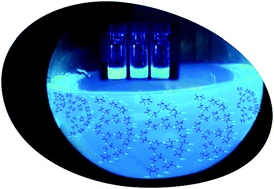New insights into the blue intrinsic fluorescence of oxidized PAMAM dendrimers considering their use as bionanomaterials†
Abstract
Like other bionanomaterials, dendrimers are usually labelled with fluorescent compounds in order to be optically detected within cells. However, this process can interfere with their biological properties, so it is crucial to find other solutions for their traceability. Here, the blue intrinsic fluorescence of amine-terminated poly(amidoamine) (PAMAM) dendrimers was enhanced using oxidative treatment with ammonium persulfate (APS). The effects of dendrimer generation (G3, G4, and G5) and pH on the spectroscopic behavior of both pristine and APS-treated PAMAM dendrimers were studied in aqueous solution. Overall, the results pointed out that there are at least two types of emitting electron-rich hetero-atomic sub-luminophores (HASLs) confined within the dendrimer scaffold that have very close maximum emission wavelengths and whose emission properties strongly depend on pH. The APS treatment significantly enhanced the fluorescence intensity by leading to the protonation of the interior of the dendrimer. However, fluorescence intensity was not only dependent on the number of HASLs in the dendrimer scaffold (i.e., on dendrimer generation), but also on the rigidification suffered by the dendrimer due to the acidic environment (at low pH values, APS-treated G4 was indeed the most emissive species). Moreover, photoluminescence studies with lyophilized samples were also conducted, which confirmed the coexistence of more than one type of HASLs emitting in the dendrimer structure. The APS treatment affected these HASLs to a different extent. Time-resolved fluorescence experiments always showed higher average lifetimes of HASLs for APS-treated dendrimers than for pristine ones, in accordance with the fluorescence intensity results. On the other hand, the fraction and lifetimes of HASLs in APS-treated dendrimers were similar in solution and the lyophilized form. This behaviour was different for the pristine dendrimers that presented increased luminescence upon aggregation. Finally, the highly emissive oxidized dendrimers were shown not only to be much less cytotoxic and hemotoxic than pristine dendrimers but also to be detectable inside cells upon excitation with UV light.



 Please wait while we load your content...
Please wait while we load your content...